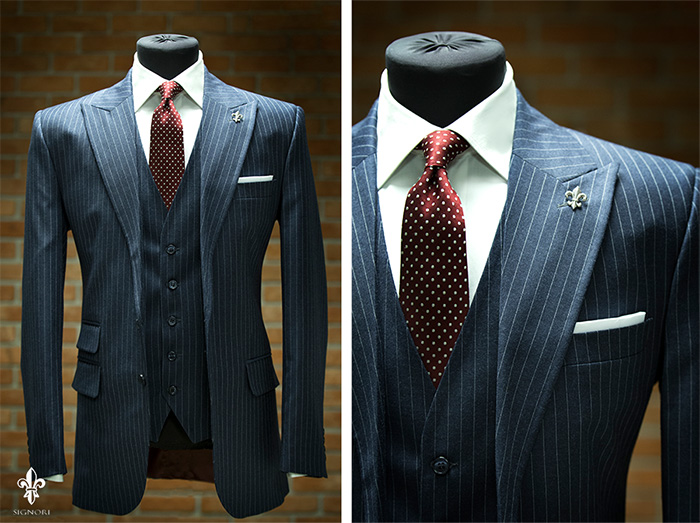
Introduction
Pinstripe suits have been popular for decades and are considered a staple by many in the banking world. Over the past few years they have seen a resurgence because of popular TV shows like Mad Men.
The pinstripe suit is a quintessential option that is far more interesting than a solid colored suit and has connotations that a lot of men would like to align themselves with.
What is a Pinstripe Suit?
It is categorized very neatly by the type of line that runs across the fabric, the direction it runs, its thickness and the distance between the stripes.
You may know that there is another pattern called ‘chalk stripe’ that is quite similar to a pinstripe but with slightly different dimensions.
A pinstripe is extremely thin, only around 1/30th of an inch in width, giving the impression of a pin being repeatedly used to mark the surface of the fabric. One single warp yarn is used to create the continuous stripe pattern, with the distance between stripes being as little as 1/10th of an inch all the way up to a whole inch.
The key with a pinstripe is to produce a ‘dot’ effect, where none of the dots are connected, but are close enough that from a distance it gives the appearance of a solid stripe.
History of the Pinstripe Suit
Pinstripe suits originated in London in the early 19th century. The pinstripe was worn on work uniforms to identify the company that you worked for and this was adopted by banks in particular who had uniforms for their men.
Originally, pinstripes were only worn on the pants and not on the jacket, but when the fashion was transplanted to America it became popular across the entire suit.

Suits and image by Oscar Hunt.
It’s generally accepted that pinstripes came into fashion in the USA after the first world war as an uplifting fashion statement after a miserable point in time.
There are two types of pinstripe; dark fabric with light stripes and light fabric with dark stripes. The dark fabric with light stripes is the most common type you’ll find and is consider more formal, whereas the light fabric with dark stripes has been used by baseball teams for decades and is considered casual.
How to Wear a Pinstripe Suit
Where to Wear Pinstripes
It’s traditional to wear this type of a suit to work, but it’s not common outside of the workplace. The pinstripe is a uniform that is associated with the East coast professional scene, it’s almost exclusively worn by bankers, lawyers and business professionals.
This lengthy history has turned into a social rule and we would recommend that you resign the pinstripe to your work closet and choose not to wear it outside of work.
Some men do choose to wear a pinstripe instead of a solid black to events where a plain black suit would be appropriate. This is up to your own preference, you should use it sparingly because it will stand out against everybody else.
What to Wear With a Pinstripe Suit
When you choose to wear any patterned suit you need to be very careful about what you choose to combine it with. It’s easy to go over the top and make your outfit too complicated.
The most important rule would be to avoid any other form of vertical stripe on your tie, shirt or shoes. If you’re choosing to use a stripe then it’s important that the eye isn’t distracted by another stripe of a different pattern that doesn’t line up.

Suit and Image from Signori.
Secondly, wear a shirt that complements the color of the stripe. Most stripes will be a white or off white color and these are best worn with a white shirt underneath. Just as you would match your pocket square to your shirt, it’s important to match your shirt to the color of the stripe.
If you don’t match the colors then you’ll find that something looks a little off and the color combination can be too much.
Your tie is where you have much more flexibility. Lots of men choose to wear a striped regimental tie with pinstripe suits but we don’t like that look at all, instead, we would recommend a polka dot print or a solid color.
As always, if you choose a pattern on your tie, you should avoid having a similar sized pinstripe. If you have widely space pinstripes then it’s best to go for a small and tight pattern on your tie, and vice versa.
When choosing the width of the individual pinstripe and the distance between each line, it all comes down to personal preference. However, the further the stripes are space and the thicker they are, the more casual the suit will be.
Closely spaced, thin strips are the most professional, because the pattern is less obvious and from a distance it looks like it could be a solid suit.
Should You Buy a Pinstripe Suit?
Our advice would be to choose a pinstripe suit as a fourth or fifth suit. It’s tough to wear a pinstripe pattern every single day because it stands out so much, people will notice that you’re wearing the same suit everyday.
Instead, we would suggest that you start with the basics; a single breasted black suit, a single breasted navy suit and a single breasted charcoal or grey suit.
Once you have these three suits, you’re ready to add a pinstripe to your wardrobe.
Because the pinstripe is so obvious, it’s recommended that you avoid wearing it multiple times per week. It might be a suit that you wear only on Mondays for example. Whereas with a solid colored suit, you can simply change your shoes or the color of your shirt and people likely won’t notice you’re wearing the same suit, a pinstripe stands out and is hard to forget.
This shouldn’t sound like we don’t recommend buying a pinstripe suit. They are actually one of our favorite types, it’s just not a good choice unless you already have a wardrobe of other choices.
